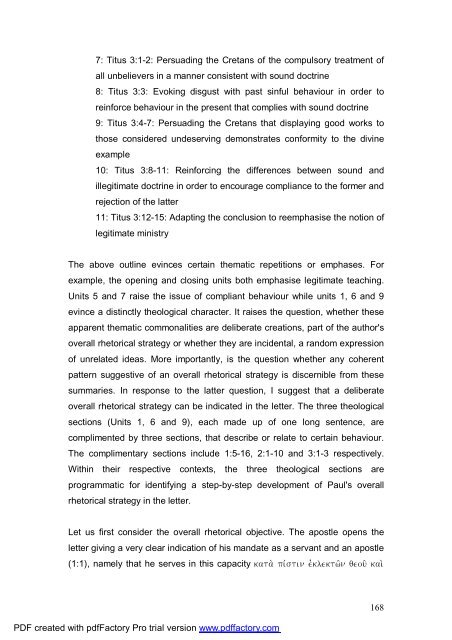A Text centred rhetorical analysis of Paul's Letter to Titus
A Text centred rhetorical analysis of Paul's Letter to Titus
A Text centred rhetorical analysis of Paul's Letter to Titus
You also want an ePaper? Increase the reach of your titles
YUMPU automatically turns print PDFs into web optimized ePapers that Google loves.
7: <strong>Titus</strong> 3:1-2: Persuading the Cretans <strong>of</strong> the compulsory treatment <strong>of</strong><br />
all unbelievers in a manner consistent with sound doctrine<br />
8: <strong>Titus</strong> 3:3: Evoking disgust with past sinful behaviour in order <strong>to</strong><br />
reinforce behaviour in the present that complies with sound doctrine<br />
9: <strong>Titus</strong> 3:4-7: Persuading the Cretans that displaying good works <strong>to</strong><br />
those considered undeserving demonstrates conformity <strong>to</strong> the divine<br />
example<br />
10: <strong>Titus</strong> 3:8-11: Reinforcing the differences between sound and<br />
illegitimate doctrine in order <strong>to</strong> encourage compliance <strong>to</strong> the former and<br />
rejection <strong>of</strong> the latter<br />
11: <strong>Titus</strong> 3:12-15: Adapting the conclusion <strong>to</strong> reemphasise the notion <strong>of</strong><br />
legitimate ministry<br />
The above outline evinces certain thematic repetitions or emphases. For<br />
example, the opening and closing units both emphasise legitimate teaching.<br />
Units 5 and 7 raise the issue <strong>of</strong> compliant behaviour while units 1, 6 and 9<br />
evince a distinctly theological character. It raises the question, whether these<br />
apparent thematic commonalities are deliberate creations, part <strong>of</strong> the author's<br />
overall <strong>rhe<strong>to</strong>rical</strong> strategy or whether they are incidental, a random expression<br />
<strong>of</strong> unrelated ideas. More importantly, is the question whether any coherent<br />
pattern suggestive <strong>of</strong> an overall <strong>rhe<strong>to</strong>rical</strong> strategy is discernible from these<br />
summaries. In response <strong>to</strong> the latter question, I suggest that a deliberate<br />
overall <strong>rhe<strong>to</strong>rical</strong> strategy can be indicated in the letter. The three theological<br />
sections (Units 1, 6 and 9), each made up <strong>of</strong> one long sentence, are<br />
complimented by three sections, that describe or relate <strong>to</strong> certain behaviour.<br />
The complimentary sections include 1:5-16, 2:1-10 and 3:1-3 respectively.<br />
Within their respective contexts, the three theological sections are<br />
programmatic for identifying a step-by-step development <strong>of</strong> <strong>Paul's</strong> overall<br />
<strong>rhe<strong>to</strong>rical</strong> strategy in the letter.<br />
Let us first consider the overall <strong>rhe<strong>to</strong>rical</strong> objective. The apostle opens the<br />
letter giving a very clear indication <strong>of</strong> his mandate as a servant and an apostle<br />
(1:1), namely that he serves in this capacity kata; pivstin ejklektw`n qeou` kai;<br />
PDF created with pdfFac<strong>to</strong>ry Pro trial version www.pdffac<strong>to</strong>ry.com<br />
168

















